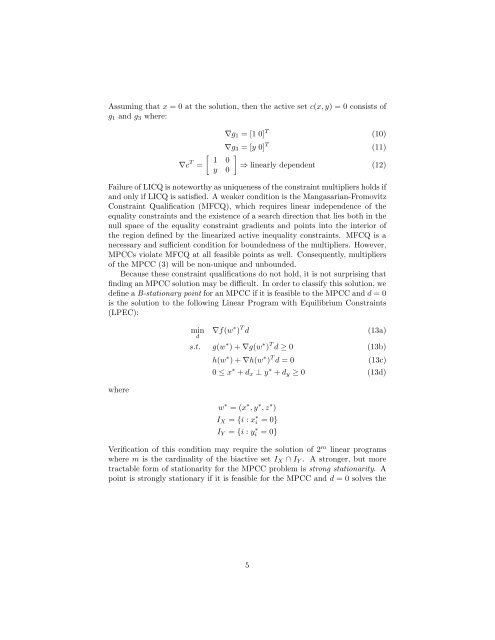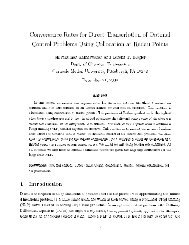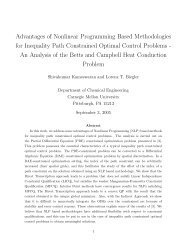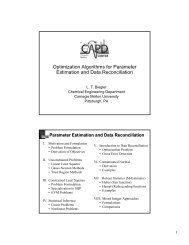MPEC Problem Formulations in Chemical Engineering Applications
MPEC Problem Formulations in Chemical Engineering Applications
MPEC Problem Formulations in Chemical Engineering Applications
Create successful ePaper yourself
Turn your PDF publications into a flip-book with our unique Google optimized e-Paper software.
Assum<strong>in</strong>g that x = 0 at the solution, then the active set c(x, y) = 0 consists ofg 1 and g 3 where:∇g 1 = [1 0] T (10)∇g 3 = [y 0] T (11)[ ] 1 0∇c T = ⇒ l<strong>in</strong>early dependent (12)y 0Failure of LICQ is noteworthy as uniqueness of the constra<strong>in</strong>t multipliers holds ifand only if LICQ is satisfied. A weaker condition is the Mangasarian-FromovitzConstra<strong>in</strong>t Qualification (MFCQ), which requires l<strong>in</strong>ear <strong>in</strong>dependence of theequality constra<strong>in</strong>ts and the existence of a search direction that lies both <strong>in</strong> thenull space of the equality constra<strong>in</strong>t gradients and po<strong>in</strong>ts <strong>in</strong>to the <strong>in</strong>terior ofthe region def<strong>in</strong>ed by the l<strong>in</strong>earized active <strong>in</strong>equality constra<strong>in</strong>ts. MFCQ is anecessary and sufficient condition for boundedness of the multipliers. However,MPCCs violate MFCQ at all feasible po<strong>in</strong>ts as well. Consequently, multipliersof the MPCC (3) will be non-unique and unbounded.Because these constra<strong>in</strong>t qualifications do not hold, it is not surpris<strong>in</strong>g thatf<strong>in</strong>d<strong>in</strong>g an MPCC solution may be difficult. In order to classify this solution, wedef<strong>in</strong>e a B-stationary po<strong>in</strong>t for an MPCC if it is feasible to the MPCC and d = 0is the solution to the follow<strong>in</strong>g L<strong>in</strong>ear Program with Equilibrium Constra<strong>in</strong>ts(LPEC):wherem<strong>in</strong>d∇f(w ∗ ) T d (13a)s.t. g(w ∗ ) + ∇g(w ∗ ) T d ≥ 0 (13b)h(w ∗ ) + ∇h(w ∗ ) T d = 0(13c)0 ≤ x ∗ + d x ⊥ y ∗ + d y ≥ 0 (13d)w ∗ = (x ∗ , y ∗ , z ∗ )I X = {i : x ∗ i = 0}I Y = {i : y ∗ i = 0}Verification of this condition may require the solution of 2 m l<strong>in</strong>ear programswhere m is the card<strong>in</strong>ality of the biactive set I X ∩ I Y . A stronger, but moretractable form of stationarity for the MPCC problem is strong stationarity. Apo<strong>in</strong>t is strongly stationary if it is feasible for the MPCC and d = 0 solves the5






